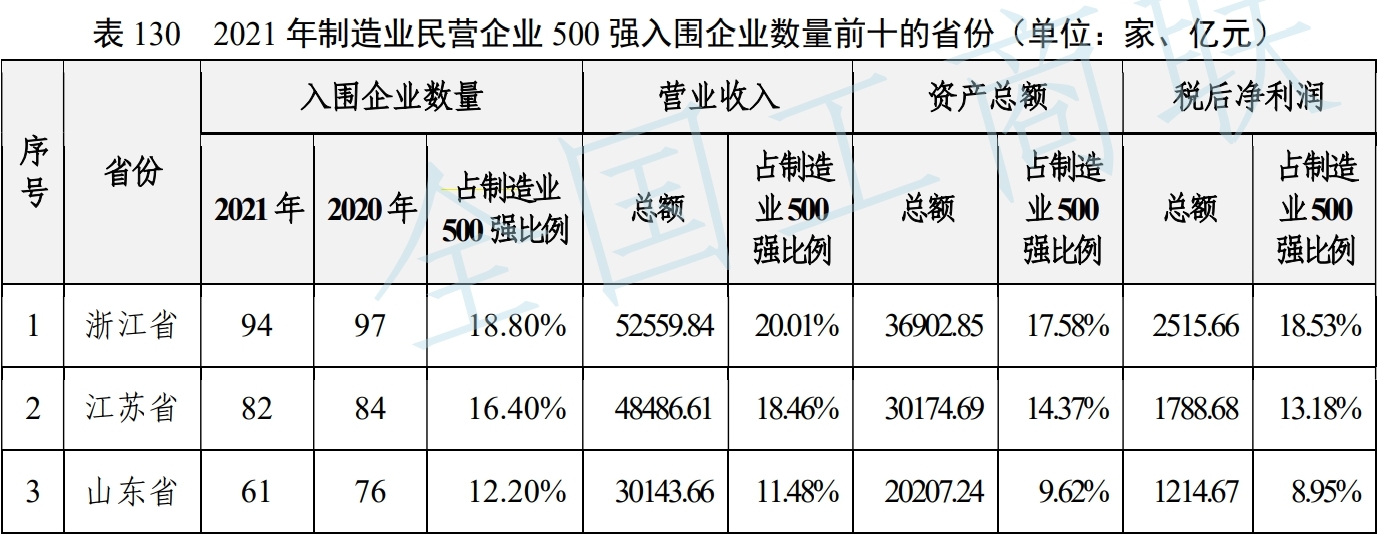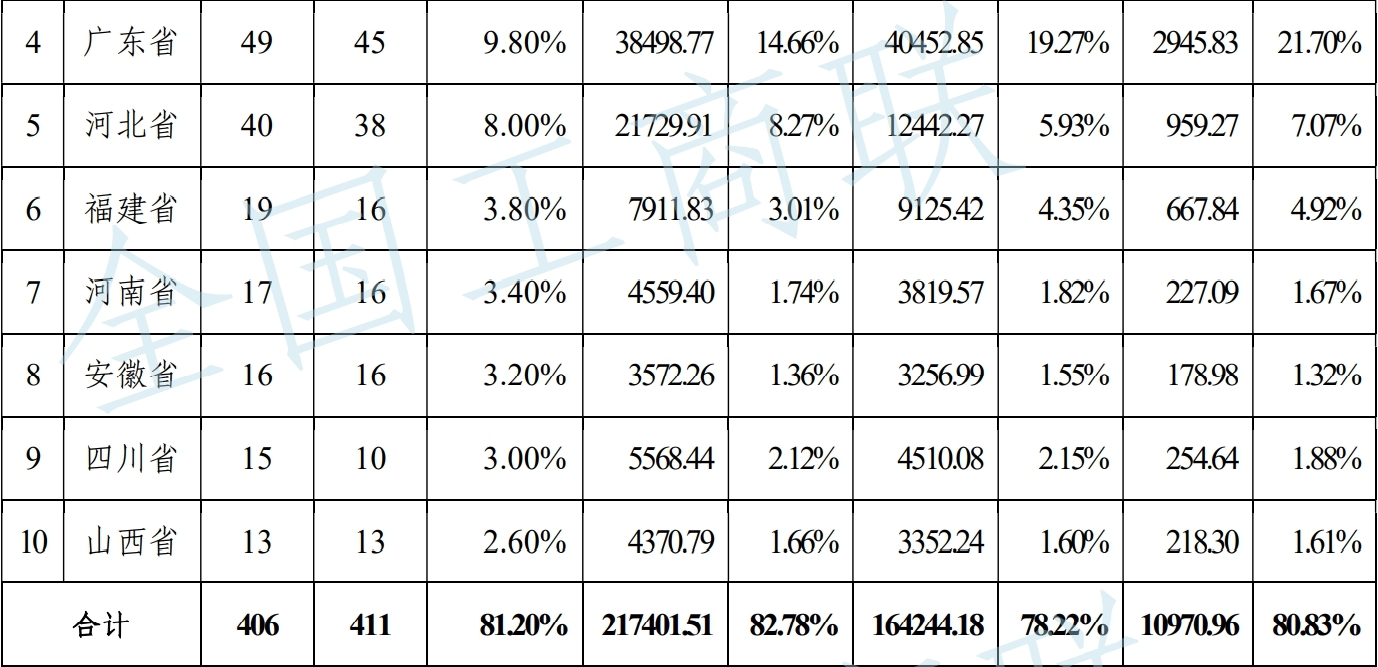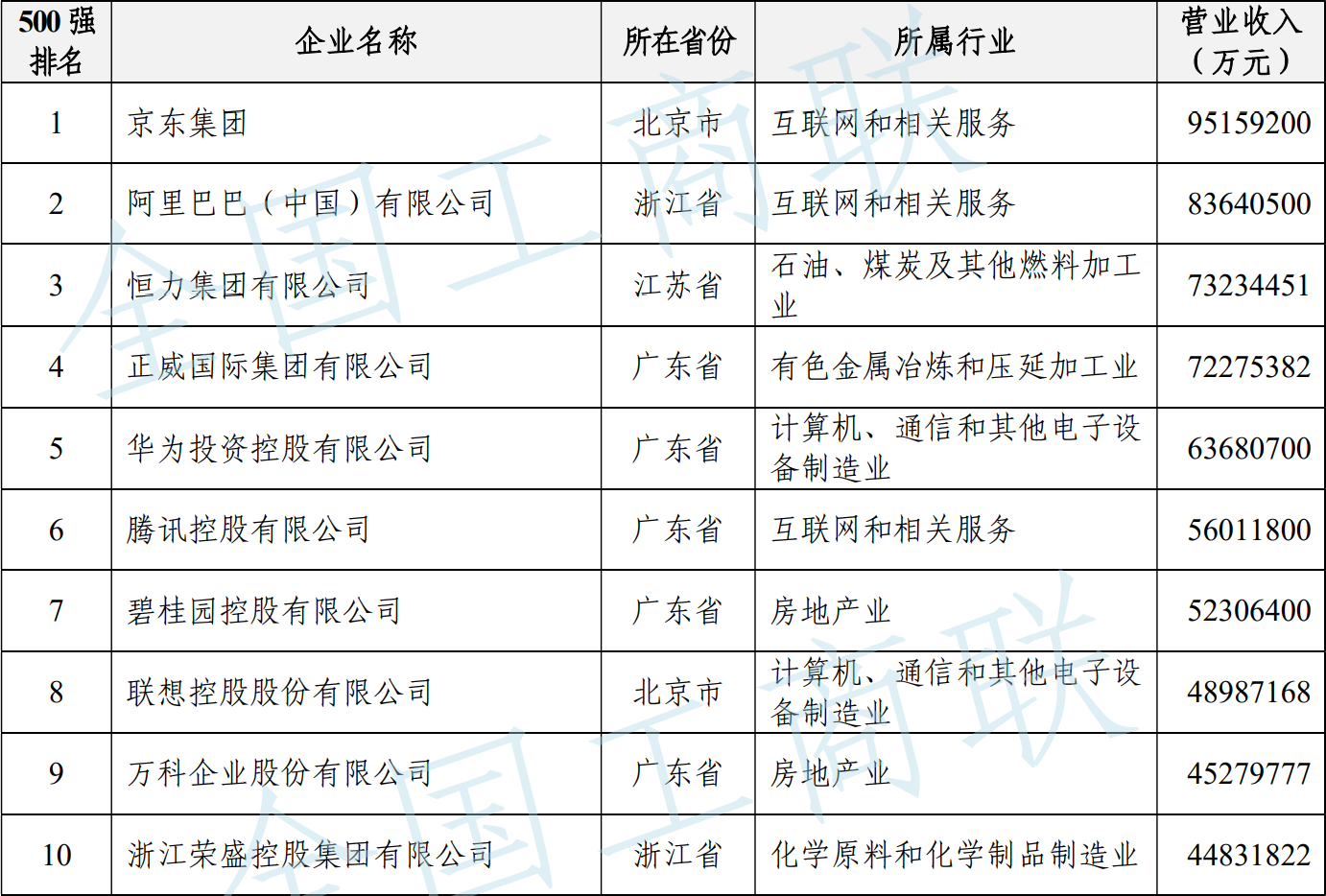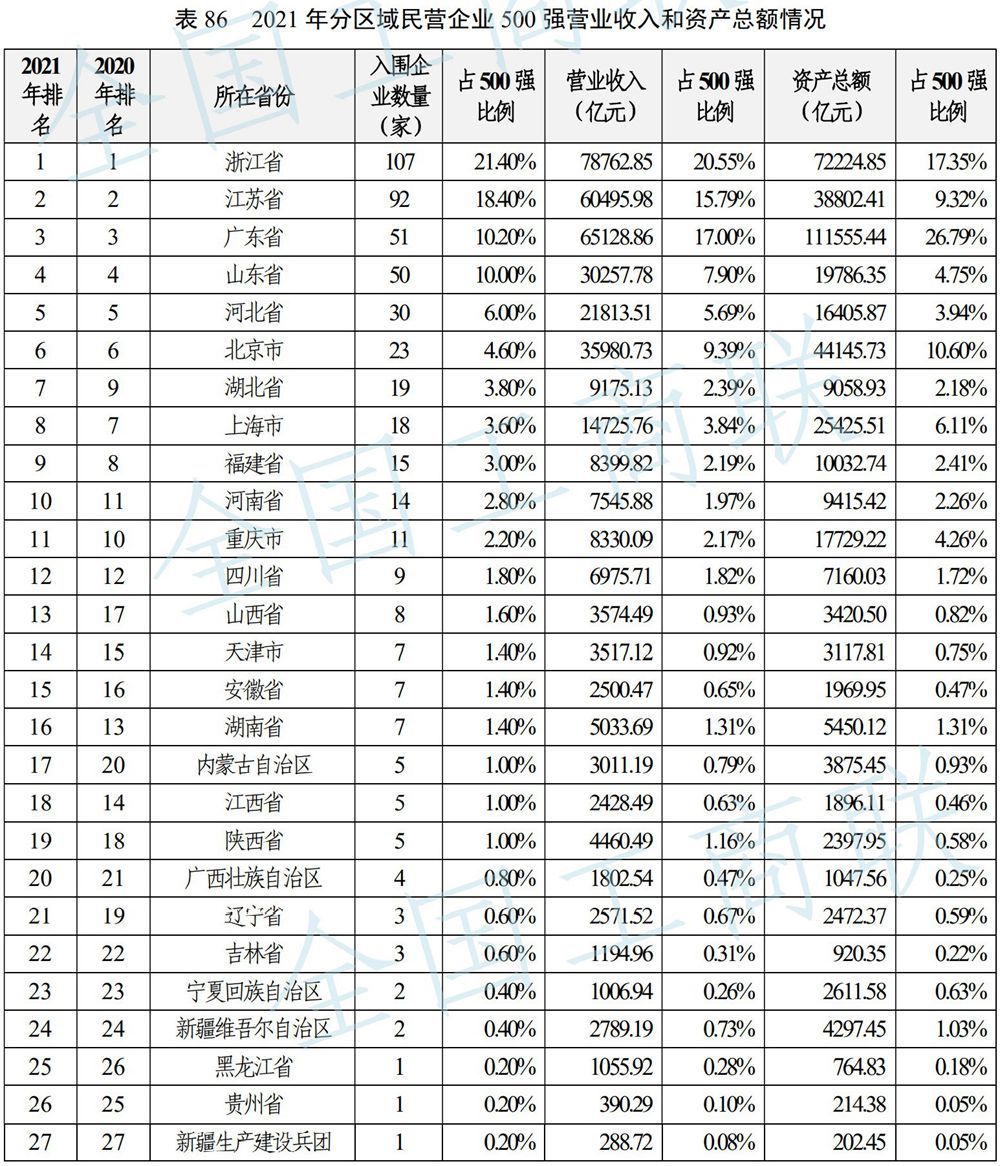Who is the first province of private economy
Author:Daily Economic News Time:2022.09.09

Picture source: Photo Network_502497493
The private economy contributed more than 50%of taxes, more than 60%of domestic GDP, more than 70%of technological innovation achievements, and more than 80%of urban labor and employment, which is an important driving force for China's high -quality development of my country's economy and society.
The Top 500 private enterprises are the "tower spire" forces of the private economy, representing the development level and activity of the regional private economy.
On September 7, the "Five Performance Research and Analysis Research Report" (hereinafter referred to as "Report") released by the National Federation of Industry and Commerce showed that in 2021, the threshold for 500 private enterprises reached 26.367 billion yuan (operating income), than It increased by 2.866 billion yuan last year. The total revenue of Top 500 private enterprises was 3.832 trillion yuan, an increase of 9.13%; the total assets were 4.164 trillion yuan, a decrease of 17.92%; net profit after tax was 1.73 trillion yuan, a decrease of 12.28%. Among them, 87 private enterprises revenue exceeded 100 billion yuan (inclusive), and 37 net profit after tax exceeded 100 billion yuan.

At present, major provinces have issued policies to support the high -quality development of the private economy as important measures. Judging from the latest list of the latest private enterprises, which provinces are standing on the tower spire and which provinces are catching up? What are the new changes and trends in the private economic regional pattern?
Regional structure
The report shows that there are 107 Fortune 500 private enterprises in Zhejiang, which is not only the only province in the country that has exceeded a hundred in the country. It accounted for one -fifth of the country's share, and the number of newly shortlisted companies also reached 11, leading the country.

Immediately after, Jiangsu, Guangdong, and Shandong reached 92, 51, and 50, respectively, and together with Zhejiang, they constituted the "head camp" in the area. The "four major King Kong" pattern is basically the same as the economic sorting, but the internal order is slightly adjusted. The GDP "Guangdong, Su, and the Luneng" pattern becomes "Zhejiang, Soviet, Guangdong and the Lu" under this indicator.
The total number of shortlisted enterprises in these four provinces reached 300, accounting for 60 % of the top 500 private enterprises, and remained stable for many years. Of course, there are also some subtle changes. For example, the number of shortlisted companies in Guangdong and Shandong decreased by 10 or three respectively compared with 2020. Among all the shortlisted provinces, Guangdong declined the most obvious.

East China Normal University and Dean of the Institute of Urban Development have just told Uncle Cheng that the overall industrial energy level of Guangdong is relatively low. Many companies migrate to Southeast Asia and the Mainland. This has a certain impact on its growth. "On the one hand, it is The pressure of low -end industries is more pressured, and on the other hand, it is more difficult to transfer from external transfer technology. "
In contrast, Zhejiang's external impact is relatively small. Zeng Gang believes that Zhejiang has a strong private economic gene, "not only the number of shortlisted private enterprises has performed well, but also performed well in terms of specialized new 'little giant' enterprises."
In addition, the number of shortlisted enterprises in 6 provinces in Hebei, Beijing, Hubei, Shanghai, Fujian, and Henan also has 14 or more, and it constitutes the top ten nationwide with the aforementioned head camp. Among them, Hubei and Henan have improved significantly. The former added three shortlisted companies, surpassing Shanghai and Fujian, and ranked 7th in the country; the latter added two new finalists, surpassing Chongqing, ranking 10th in the country in one fell swoop.
As a dynamic list, "entering and having" is normal. In the latest list, in addition to the decrease in the number of shortlisted companies in Guangdong and Shandong, the number of shortlisted companies in Shanghai, Fujian, and Chongqing also reduced 3, 2, and 2 respectively. Chongqing was squeezed out of the top ten.
On the whole, among 27 provinces and Xinjiang Production and Construction Corps this year, 10 provinces have maintained the number of shortlisted enterprises, 9 are the same as last year, and 8 provinces have increased negative growth. Among them, Junfa Group (real estate development industry), which ranked 281st last year, fell out of the top 500 list this year, and Yunnan followed zero. In addition, Hainan, Gansu, Qinghai, and Tibet have not broken zero.

In terms of regional distribution, the eastern region decreased by 8 compared with the previous year, the central region increased by 9, the western region was the same as the previous year, and the northeast region was reduced by 1. The growth momentum in the central region is obvious, reflecting the greater potential of the development of the private economy.
Manufacturing strength
The manufacturing industry is the foundation of the country and the foundation of a strong country, and it is the national economic life pulse. In the context of the "keeping the proportion of manufacturing", the role of private enterprises in it is becoming more and more prominent.
The report shows that the number of private enterprises in the manufacturing industry has reached 301, an increase of 24 compared with the previous year, accounting for 60 % of the top 500 private enterprises in the country, and has become the most important support for the private economy.
Among them, a number of core indicators of manufacturing and private enterprises have improved significantly. For example, in terms of employment, the employment of private enterprises in manufacturing reached 5.8554 million, an increase of 450,000, accounting for the top 500 private enterprises from 47.17%to 53.52%.
The report also released a list of Fortune 500 private enterprises. In 2021, the threshold for the fighter of private enterprises in manufacturing continued to increase from the previous year, reaching 12.572 billion yuan, an increase of 25.08%, and the growth rate remained high for two consecutive years.

From the perspective of the provinces, Zhejiang led the country again with the number of shortlisted companies in Zhejiang. 82 Jiangsu followed, and Shandong ranked third with 61, and Guangdong ranked fourth with 49 in Guangdong. The total number of shortlisted enterprises in these four provinces reached 286, which also occupied nearly 60 % of the top 500 private enterprises in manufacturing, and its status cannot be shaken.


However, in addition to Guangdong, the number of shortlisted companies in the other three provinces show a decline. In the fifth place, Hebei, the number of private enterprises in the manufacturing industry reached 40, an increase of 2 compared with the previous year. In addition, Fujian, Henan, Anhui, Sichuan, and Shanxi are also among the top ten, and the number of shortlisted companies has not exceeded 20, but the overall growth trend is also the most intense range of the provincial competition in manufacturing and private enterprises. Among them, 3 and one of Fujian and Henan were added; Anhui and Shanxi were the same as last year; the most dazzling is Sichuan, which surpassed Shanxi, Tianjin and other provinces with the increase of five, and ranked 9th in the country.
This promotion momentum is also obvious in the scale of the private economy. In 2021, the added value of Sichuan's private economy reached nearly 3 trillion yuan, an increase of 8%over the previous year. As of the end of last year, Sichuan's private economy contributed 46.9%of its investment, 54.5%of regional GDP, 65.5%of taxes, 88.9%of new employment, and 97.4%of market entities.
In addition, the data also showed that in 2021, Sichuan's private technology -based SMEs increased by 14,656, an increase of 19.36%year -on -year, accounting for 99.71%of the province; 8,561 private high -tech enterprises, a year -on -year increase of 5.65%, accounting for 98.66%of the province. From the perspective of Sichuan Provincial CPPCC member Yanhua, from the perspective of corporate scientific and technological innovation, private enterprises are not only leaders, they are almost all "responsible". The future way out of private enterprises must still be "specialized in specialty".
Head competition
Compared with the number of shortlisted companies, the overall scale and benefits are also an important indicator for measuring the development level of the regional private economy. Among them, corporate revenue scale and total assets are two important indicators.
From the perspective of operating income, Jingdong, a representative of Beijing companies, successfully reached the top and replaced Huawei with 951.592 billion yuan, becoming the first private enterprise in the country. As a representative of Zhejiang Enterprises, Alibaba has been promoted to the second in the country for 836.405 billion yuan. It is worth mentioning that the operating income of these two major private enterprises reached 182.9 billion yuan and 192.2 billion yuan, respectively. This volume is enough to exceed 90%of the revenue of private enterprises across the country.
2022 The top ten of the top 500 list of Chinese private enterprises

From this perspective, compared with a single number of enterprises, the size of the enterprise may better reflect the regional private economic strength.
In fact, in terms of the number of private enterprises, Zhejiang has dominated the list for 24 consecutive years. However, in terms of the overall revenue scale, Zhejiang has been pressed by Guangdong in the past, and private enterprises are "more instead of strong" is a big pain point.
According to the top 500 private enterprises last year, the total revenue of Guangdong and Zhejiang's finalists was 6.6 trillion yuan and 6.3 trillion yuan, respectively, nearly 300 billion yuan. However, this year, the situation reversed in one fell swoop. The total revenue of Zhejiang's finalists reached 7.9 trillion yuan, surpassing Guangdong in one fell swoop, and won the "double material champion" of the total number and total revenue.
In contrast, the total revenue of Guangdong's finalists was 6.5 trillion yuan, retreating to the second place in the country. The gap with Zhejiang has also expanded to 1.4 trillion yuan, and its leading advantage in Jiangsu has also reduced from 800 billion yuan to more than 400 billion yuan.

Under the influence of many uncertain factors such as the repeated epidemic and the international situation, Zhejiang's retrograde growth showed the strong toughness of its private economy. For example, the average net profit margin of its finalists was 5.31%, the highest value in the past five years, and the net asset yield and total asset net interest rate have also increased significantly year -on -year.
In Zeng Gang's view, Zhejiang, which is in the Yangtze River Delta region, is lower to external technology, and the Yangtze River Delta integrated promotion provides a good surrounding environment for its development.
In contrast, Guangdong is facing greater pressure in industrial upgrading. For example, although Shenzhen's technological achievements have been transformed well, most of the technologies are introduced from the outside. Earlier, there were a lot of technical transfer (to Shenzhen) (to Shenzhen), "but now from the data, the proportion of technology transfer from Beijing to Shenzhen has decreased, because many high -end industries are also developing. "
Nevertheless, the total assets of Guangdong's finalists reached 11.16 trillion yuan, and 26.79%of the top 500 private enterprises were exclusive, and nearly 4 trillion yuan ahead of Zhejiang.
Judging from the top ten private enterprises in the national revenue, Guangdong has won 5 seats, while only two in Zhejiang. This also reflects the powerful chassis of the country's first economic province. Who can sit in the first province of private economy in the country, or there is still suspense.
Daily Economic News
- END -
The active changes in my country's economic operations have increased: industrial production has been significantly accelerated from decreasing to foreign trade imports and exports

In May, industrial production has increased from decline, foreign trade imports an...
Global gold demand in the second quarter decreased by 8% year -on -year

On July 28, the World Gold Association released the Global Gold Demand Trends Repo...